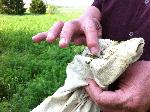LINNEUS, Mo. – Native warm-season grasses may gain a growing place in Missouri pastures. They can survive and thrive in summer.
When cool-season grasses stop growing in hot months, that summer slump brings a challenge. Livestock producers need something besides fescue or other cool-season grasses.
Rob Kallenbach is changing his recommendations. After years of testing summer annual grasses, he can’t find consistently good results.
He will explain his findings at a field day, Sept. 25, at University of Missouri Forage Systems Research Center in Linn County. The center is part of the MU College of Agriculture, Food and Natural Resources, Columbia.
“Annual grasses give erratic results,” says the MU Extension specialist. “Some years they give great results. But just when you need them, they may not repay cost and labor in planting.”
This wasn’t a quick change in thinking. Kallenbach has been testing summer annuals for several years in FSRC grazing paddocks. He compared his best alternatives: pearl millet, crabgrass and two types of forage sorghum. The grazing sorghums include a dwarf variety and a regular tall variety.
We’ve learned a lot about seeding and fertilization, Kallenbach says. But the big thing learned: They are inconsistent.
“You can get some really good results. Some years you’ll graze June to September. Then, just when you think you know what you are doing, you get a curveball. The annuals start a month late, or six weeks late. It’s a pain.
“It’s a terrible message. You can get 6 tons of dry matter per acre. But you’ll average 2.5 tons per acre. The economics are not there.”
Kallenbach falls back on his original recommendations. “Every farm has place for some native warm-season grasses such as big bluestem or Indian grass.”
The perennials, once established, are there waiting for the summer slump. “The perennial native grasses have a place, but don’t overplant,” Kallenbach says. They tie up land year-round for that summer grazing period. About 15 percent of the grazing land should be enough.
Maybe nature had the answer. Those warm-season grasses covered much of the state in pre-settlement days.
There is more to the story on summer annuals. They make a smother crop for killing toxic Kentucky 31 fescue. They have a place, just not as big as hoped, Kallenbach will tell.
During the field day, beef cow herd and natural resource management are on other tours.
The MU FSRC field day starts with registration at 8 a.m. and tours run 9 a.m. to noon, when lunch will be served, says David Davis, superintendent. The event is free and open to the public.
FSRC is at 21262 Genoa Road, Linneus, MO 64653. To reach the farm, go west from Brookfield, on U.S. Highway 36 to Highway FF, then north 6 miles to Genoa Road. Go west. Or from Linneus, on Highway 5, go east 2 miles on Highway P to Finn Road. Go 1 3/4 miles to Genoa Road and turn east to the office. Signs are at the intersections.
Read more http://extension.missouri.edu/news/DisplayStory.aspx?N=1979





